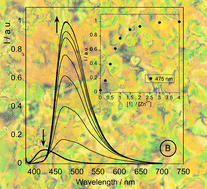Exploring photophysical properties of new boron and palladium(ii) complexes with β-diketone pyridine type ligands: from liquid crystals to metal fluorescence probes†
Abstract

* Corresponding authors
a
Departamento de Química Inorgánica I, Facultad de CC. Químicas, Universidad Complutense de Madrid, Madrid, Spain
E-mail:
mmcano@quim.ucm.es
Fax: +34 91394 4352
Tel: +34 91394 4340
b REQUIMTE-CQFB, Facultade de Ciencias e Tecnologia, Universidade NOVA de Lisboa, Caparica, Portugal
c
Grupo BIOSCOPE, Departamento de Química-Física, Facultade de Ciencias, Campus de Ourense, Universidade de Vigo, Ourense, Spain
E-mail:
clodeiro@uvigo.es
Fax: +34 98838 7001
Tel: +34 98836 8894

 Please wait while we load your content...
Something went wrong. Try again?
Please wait while we load your content...
Something went wrong. Try again?
M. J. Mayoral, P. Ovejero, J. A. Campo, J. V. Heras, E. Oliveira, B. Pedras, C. Lodeiro and M. Cano, J. Mater. Chem., 2011, 21, 1255 DOI: 10.1039/C0JM02698K
To request permission to reproduce material from this article, please go to the Copyright Clearance Center request page.
If you are an author contributing to an RSC publication, you do not need to request permission provided correct acknowledgement is given.
If you are the author of this article, you do not need to request permission to reproduce figures and diagrams provided correct acknowledgement is given. If you want to reproduce the whole article in a third-party publication (excluding your thesis/dissertation for which permission is not required) please go to the Copyright Clearance Center request page.
Read more about how to correctly acknowledge RSC content.
 Fetching data from CrossRef.
Fetching data from CrossRef.
This may take some time to load.
Loading related content
